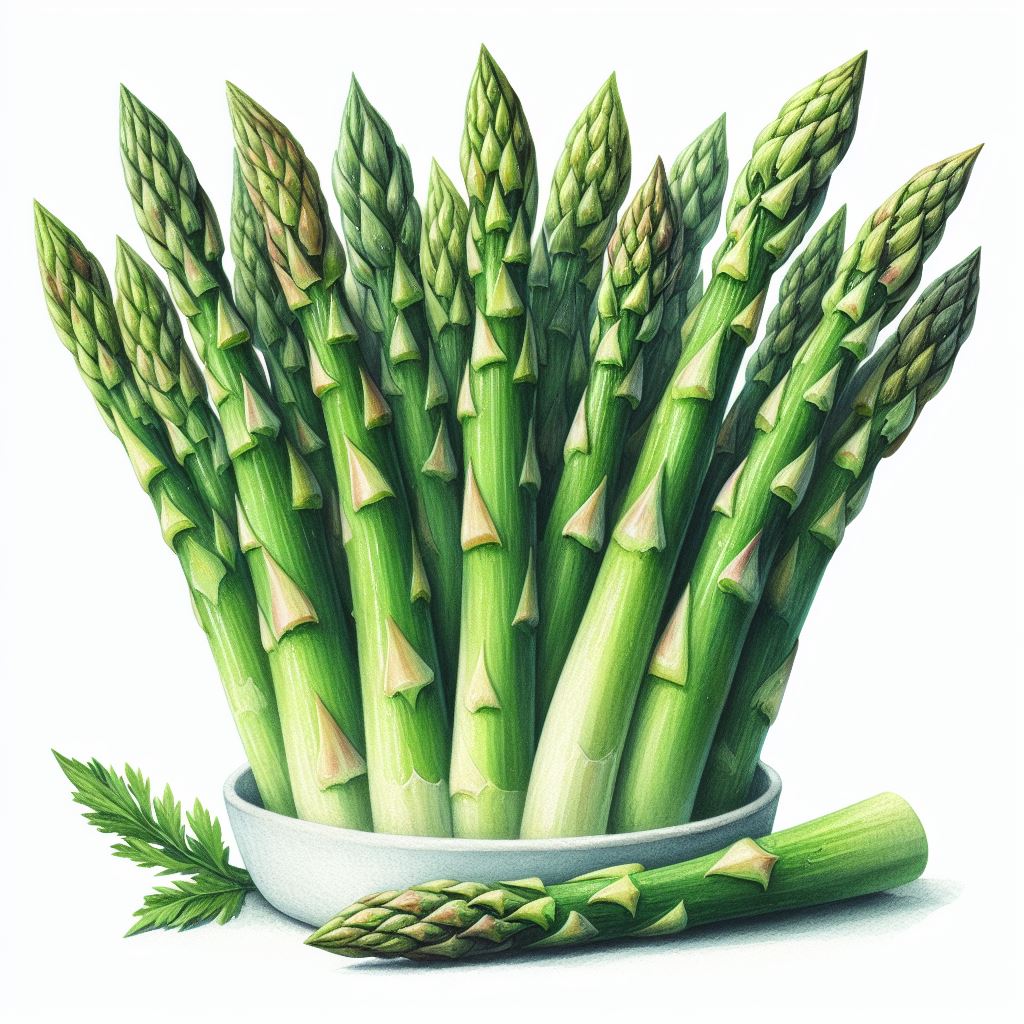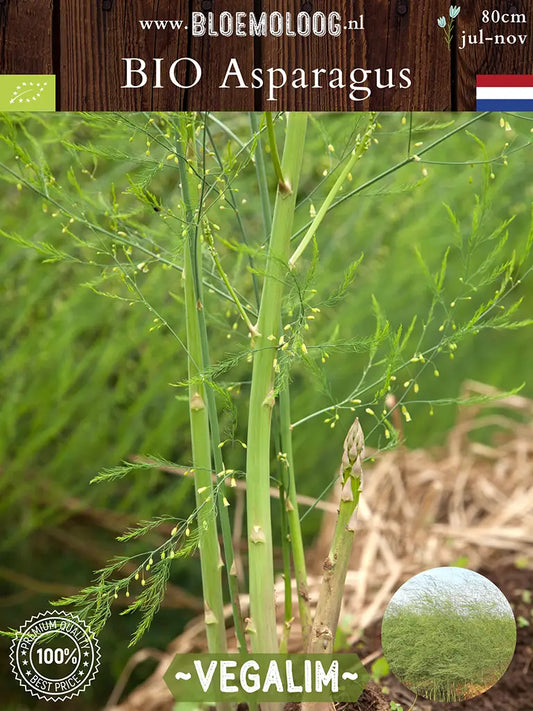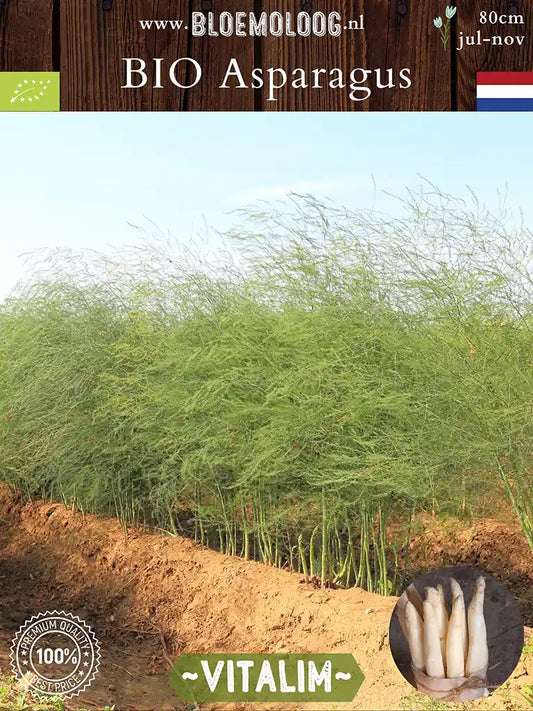
Summer bloomers
-
Organic Asparagus 'Vegalim' (green asparagus)
Regular price €2,99Regular price -
Organic Asparagus 'Vitalim' (white asparagus)
Regular price €2,99Regular price
Collection: Organic asparagus
Organically grown asparagus claws
Not everyone likes asparagus, but we certainly wouldn't advise anyone against growing their own. The plant itself is quite a sight with its striking foliage, which grows quite tall as it develops. They are perennials that return faithfully every year.
Asparagus contains nutrients such as vitamin C, vitamin K, folate and fiber and is also a good source of antioxidants.
Edible
The Bloemoloog's asparagus plants produce asparagus intended for human consumption. Asparagus can be prepared in various ways, including roasting, grilling, steaming, or boiling. Because it is more tender than white asparagus, it often requires a shorter cooking time.
Click here for delicious recipes from Chef Alain of Binnenstebuiten TV.
Growing green asparagus
The Bio Asparagus 'Vegalim' is a green asparagus. The most striking feature of green asparagus is, of course, the green color of its stalks. Unlike white asparagus, green asparagus grows above ground and is exposed to sunlight, allowing photosynthesis to occur. Green asparagus is grown in a similar way to white asparagus, but with one important difference: it is not covered with soil during growth. Because it grows above ground, it has no protection from sunlight, resulting in its green color.
Green asparagus often has a slightly stronger flavor than white asparagus. It also tends to be slightly more tender and juicier.
Growing white asparagus
The Bio Asparagus 'Vitalim' is an asparagus plant suitable for growing white asparagus. When growing white asparagus, it's important to cover the asparagus stalks with a thick layer of soil during the growing season, also called an asparagus ridge. This process is known as "earthing up" or "bleaching" and is essential to prevent the asparagus from turning green due to exposure to sunlight. In the dark, the plant doesn't produce chlorophyll, so it remains white.
White asparagus is softer and has a less intense flavor.
How, where and when do I plant claws from an asparagus plant?
The ideal time to plant asparagus claws is in early spring, when the soil has warmed up but before the asparagus begins its active growth period.
Dig trenches about 15 to 20 centimeters deep. Leave at least 1 meter between the trenches. Place the asparagus claws in the trench with the buds facing up. Leave about 30 to 45 centimeters between each claw. Cover the claws with about 5 to 8 centimeters of soil. As the asparagus grows, gradually add more soil until the trench is level with the ground surface.
Planting white asparagus
For white asparagus, begin by gradually adding soil to the furrow or bed where the asparagus stalks are planted. Do this as the asparagus grows, and continue filling the furrow until it reaches approximately 20 to 30 cm above the original ground level.
Only have one asparagus spear to try? Dig it to the same depth as described above, but without a furrow.
Water the asparagus beds thoroughly after planting to settle the soil and give the asparagus a good start. Consider mulching the asparagus beds to retain moisture, reduce weed growth, and stabilize the soil temperature.
Location
Asparagus thrives best in full sun, in well-drained soil with a pH between 6.5 and 7.5. Well-draining soil is essential to prevent root rot. Sandy soil is ideal, but light loam is also fine. Avoid heavy clay.
Caring for the asparagus plant
Asparagus needs regular watering, especially during dry spells. Water deeply to ensure the roots stay well hydrated. Once the plant has completely died back in autumn, cut the remains down to the ground to prevent pests and diseases.
Asparagus beds can last for decades if properly maintained. Continue feeding the plants and ensuring good soil health.
For organic potting soil, plant food, and other soil improvers, we recommend Bio Kultura !
How do I harvest asparagus?
Don't start harvesting until the second year after planting the asparagus stalks. In the first year, it's important to let the plants grow and become stronger.
Harvesting green asparagus
Harvesting green asparagus begins when the stalks reach the desired height, usually between 20 and 25 centimeters. They are simply cut with a knife just above the soil surface. The harvest season for green asparagus is often slightly longer than that of white asparagus. It begins in spring and can extend into early summer, depending on growing conditions and climate.
Harvesting white asparagus
White asparagus should be harvested when it reaches a height of about 20-25 centimeters. This is when it is still growing underground and retains its characteristic white color. The harvest season for white asparagus is shorter than that of green asparagus, from March to June.
Harvesting white asparagus that grows underground requires care and precision to avoid damaging the stalks. Use a specialized asparagus pick or knife. This tool is designed to cut the asparagus below ground without damaging the roots or other stalks.
Locate the asparagus bud by gently pushing away the soil around the asparagus with your hand. The asparagus bud is located at the top of the stalk. Insert the asparagus picker or knife about 6 to 8 inches (15 to 20 centimeters) below the ground, near the base of the stalk, and carefully cut through the stalk. Cut at an angle, just below the asparagus bud. Carefully pull the cut asparagus up from the ground, making sure to leave the length of the stalk intact.
Continue harvesting the white asparagus until all mature spears have been harvested. Because white asparagus is harvested only once a year, it's important to be careful not to damage the plants.
After the asparagus has been harvested, the hole in the ground is backfilled using a rake or simply by hand.
Propagation
Asparagus stalks can become thicker over time. You can divide older plants to obtain new root cuttings. Replant the root cuttings in the desired location.
Origin of the asparagus plant
Asparagus is an ancient vegetable that has been cultivated for thousands of years. Its origins likely lie in the coastal regions of Europe, Western Asia, and North Africa. The ancient Egyptians, Greeks, and Romans were familiar with asparagus and valued it for both culinary and medicinal reasons. Asparagus was considered a delicacy and believed to have medicinal properties, such as a beneficial effect on the kidneys.
Buy organic asparagus
You can buy organic asparagus plants from January to April at Bloemoloog.nl.
Estimated Shipping Widget will be displayed here!
-
Organic summer bulbs
Summer flowering bulbs and tubers are a promising and colourful addition to gardens, bringing them to life during the warmer months. Here you will find a wide range of flowers and plants that are planted in spring and produce beautiful flowers throughout the summer and autumn.
Planting summer bloomers
Planting summer flowering bulbs and tubers usually requires some preparation in the spring. They thrive in well-drained soil and generally require full sun or light shade.
Pre-growing flower bulbs
You can also choose to grow the frost-sensitive summer bloomers indoors from March, which is called pre-growth. The plant then has a head start and will flower earlier. You then place the pot in a light place in your room and keep the soil slightly moist. As soon as the night frost has gone, the pot can be placed outside or the flower bulb or tuber can be removed and replanted in the open ground. In that case, first keep the pot in a bucket of water for half a day and then plant the tuber in the open ground.
Caring for summer bloomers
Regular watering and removing faded flowers can prolong flowering. All summer flowering plants we offer can be cut back to the ground in the fall. For further instructions, we recommend reading the respective product descriptions for correct wintering.
For organic potting soil, plant food and other soil improvers we recommend Bio Kultura !
Summer buzzers
The entire range of the Bloemoloog is organically grown. This means you don't have to worry about whether it contains harmful substances for beneficial insects such as bees and other summer buzzers.
-
What summer bloomers are there and how do you choose the right one?
There are many different types of summer bloomers, including annuals and perennials, also known as perennials. Annual summer bloomers bloom for only one season, while perennials grow and flower for several years. Some need to be dug up before the cold winter, while others, with proper care, can remain in the same spot for years.
When choosing summer bloomers, it is important to consider the specific needs of the plants, such as water requirements, soil type and care.
Below we discuss some popular summer bloomers and provide information on which location is best for them.Non-hardy perennial summer bloomers
Dahlia: Dahlias are a popular choice for summer bloomers and come in many different colors. They thrive in full sun.
Gladioli: Gladioli are perennial, but not winter-hardy. They grow best in full sun.Winter-hardy perennial summer bloomers
Kniphofia: Kniphofia, also known as firecracker, loves plenty of sunlight. Place the plant in a location where it gets at least 6 to 8 hours of direct sunlight per day. A sunny spot ensures the plant grows and blooms well.
Lily: Lilies are perennial summer bloomers that are often planted. These plants thrive in full sun and partial shade.
Peony: Peonies are well-known summer perennials. They thrive in the sun, but for longer blooms, we recommend a semi-shaded spot.




